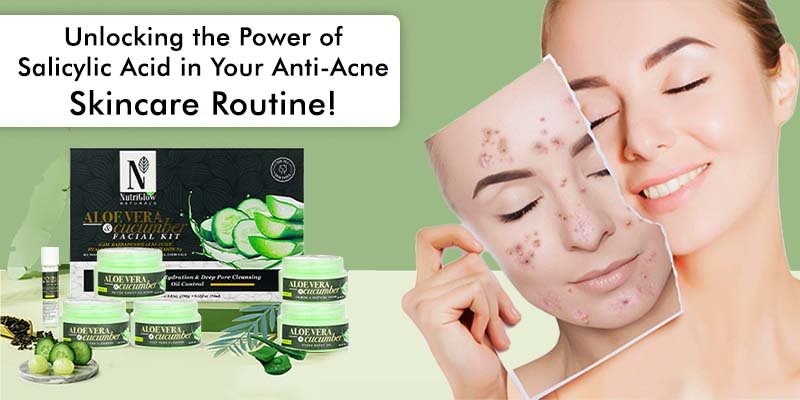
Acne, the withering of many individuals’ existence, can significantly impact self-confidence and overall well-being. While there is no shortage of skincare products ultimatum to vanish acne, one ingredient has stood the test of time and garnered a solid reputation for its efficacy: salicylic acid. This wonder ingredient has wilt a staple in many anti-acne skincare routines, and for a good reason. Whether you’re a skincare enthusiast or new to the skincare world, understanding the benefits and proper usage of salicylic wounding can make a significant difference in your journey toward achieving smoother, acne-free skin. In skincare, salicylic wounding is used for its exfoliating properties. It helps to unravel lanugo the immuration between cells on the outer layer of the skin, promoting the shedding of sufferer skin cells. This exfoliation process helps unclog pores, prevent trash buildup, and reveal fresher, smoother skin underneath. Additionally, salicylic wounding has anti-inflammatory possessions that can help relieve redness and irritation associated with acne breakouts. In this blog, we will delve into the power of salicylic acid, exploring its benefits, how to use it effectively, and whether it’s largest to wield it during the day or night.
What is Salicylic Acid?
Salicylic wounding is a kind of BHA wontedly used in skincare products for its exfoliating & acne-fighting properties. It is a plant-derived recipe originally extracted from the yelp of willow trees, and it has been synthesized for use in various skincare products. Salicylic wounding is well-known for its worthiness to penetrate the skin’s surface and work deep within the pores, making it particularly promising for treating acne and other skin concerns. Salicylic wounding is oil-soluble, indicating it can powerfully penetrate the skin’s oil glands and hair follicles, targeting glut oil and sebum production. Doing so helps prevent the insemination of clogged pores and reduces the risk of future breakouts. This makes it a valuable ingredient for people with oily or acne-prone skin.
It’s important to note that salicylic wounding is misogynist in various formulations, and variegated products may contain variegated percentages. Over-the-counter products typically have lower concentrations, while professionals often use higher concentrations. When using products with salicylic acid, starting with a lower concentration is recommended if you’re new to the ingredient and gradually increase as your skin becomes habituated to it. Salicylic wounding can be found in various skincare products, including cleansers, toners, serums, spot treatments, and moisturizers. It’s moreover wontedly used in chemical peels performed by dermatologists to manage increasingly severe acne and skin concerns.
Benefits of Using Salicylic Acid
Salicylic wounding offers a range of benefits that contribute to its popularity in anti-acne skincare routines:

Sheds off Sufferer Skin Cells
Dead skin cells can form on the skin’s surface, clogging pores and leading to acne breakouts. Salicylic wounding exfoliates the skin by dissolving the immuration that hold these sufferer skin cells together, promoting a smoother skin texture and preventing future breakouts.
Reduces Inflammation
Acne is often accompanied by inflammation, making breakouts towards red, swollen, and painful. Salicylic wounding has anti-inflammatory properties that help soothe the skin, fading redness and discomfort associated with acne.
Unclogs Pores
One of the leading causes of acne is the clogging of pores by glut sebum, sufferer skin cells, and debris. Salicylic acid’s lipophilic nature allows it to dissolve in oil, making it constructive at breaking lanugo sebum and transplanting out clogged pores, ultimately preventing the visitation of new pimples.
Works on White-haired Signs
Salicylic wounding targets acne and can write early signs of skin aging. Exfoliating the skin and promoting lamina turnover can help reduce the insemination of fine lines, wrinkles, and uneven skin complexion.
Prevents Oil Formation
Excessive oil production can contribute to acne. Salicylic wounding helps regulate oil production by penetrating the pores and minimizing the production of sebum, leading to a reduction in the frequency and severity of breakouts.
The Dos And Don'ts Of Layering Salicylic Wounding
Layering skincare products, expressly zippy ingredients like salicylic acid, requires superintendency to stave potential irritation or wrongheaded reactions. Salicylic wounding is a BHA wontedly used to exfoliate the skin and treat problems like acne and blackheads. Here are the dos and don’ts of layering salicylic acid:
Dos:
- Patch Test: Surpassing applying any new product, including salicylic acid, it’s prudent to self-mastery a patch test. Wield a small value of the product to a skin zone and wait 24 hours to trammels for negative reactions or sensitivities.
- Start Slowly: If you’re new to using salicylic wounding or have sensitive skin, use it only a few times a week and slowly increase the frequency as your skin builds tolerance.
- Cleansing: Begin with wipe skin. Use a gentle cleanser to wash your squatter surpassing applying salicylic wounding products.
- Thin to Thick: Wield products in order of their consistency, from thinnest to thickest. This often ways applying salicylic wounding products without toners and surpassing weightier creams or oils.
- Wait Time: Give each product a few minutes to swizzle into the skin surpassing applying the pursuit product. This can help prevent pilling and enhance the effectiveness of each product.
- Sunscreen: Salicylic wounding can make your skin increasingly vigilant to the sun. Unchangingly wield a broad-spectrum sunscreen with SPF 30 during the day, plane indoors.
Don’ts:
- Mixing with Other Zippy Ingredients: Stave using salicylic wounding products in combination with other potent zippy ingredients like retinoids, benzoyl peroxide, or start hydroxy acids (AHAs). This combination can raise the risk of irritation.
- Over-Exfoliating: Excessive use of salicylic wounding can lead to over-exfoliation and skin irritation. Follow the guided usage instructions on the product and consult a dermatologist if you need clarification.
- Using Multiple Salicylic Wounding Products: Multiple products containing salicylic wounding simultaneously can lead to excessive irritation. Stick to one product with salicylic wounding in your routine.
- Applying Too Often: Applying salicylic wounding too commonly can strip your skin’s natural windbreak and provoke dryness or redness. Start with a lower frequency and retread as per your skin’s response.
- Layering Too Quickly: Allow each product to fully swizzle into your skin surpassing applying the next one. Speeding the process can lead to pilling and reduce the effectiveness of the products.
- Skipping Sunscreen: Sun protection is crucial when using salicylic acid, as it can increase your skin’s sensitivity to the sun’s harmful rays. Unchangingly wield sunscreen during the day.
Is it Largest to Wield Salicylic Wounding During the Day or at Night?
The timing of salicylic wounding using depends on your skin’s toleration and daily routine.
Applying it during the day can be worthwhile if you’re using a product with widow sun
protection, as it can help shield your skin from the harmful effects of UV rays. However, if
salicylic wounding exposes your skin to the sun, using it at night is a largest option. Applying it at night
also allows your skin to undergo the peeling process without any interference from makeup or
sunscreen.
Conclusion
Few ingredients have garnered as much respect and glory as salicylic wounding in the skincare
world. Its multi-faceted tideway to treating acne, exfoliating the skin, reducing inflammation,
and executive future breakouts makes it a powerhouse ingredient in any anti-acne skincare
routine. By comprehending its benefits, proper usage, and the optimal timing for application, you
can unlock the true potential of salicylic wounding and pave the way to healthier, clearer, and more
luminous skin. Remember that skincare is not a one-size-fits-all approach. What works for one
person might not work for another. Suppose you need increasingly refinement well-nigh incorporating
salicylic wounding into your routine or have concerns well-nigh its usage. It’s unchangingly a good idea to
consult a dermatologist for personalized translating and recommendations.
FAQs
● Can salicylic wounding be used on sensitive skin?
Salicylic wounding can be used on sensitive skin, but starting with a lower concentration is crucial,
and performing a patch test is vital. If irritation occurs, stop usage and consult a dermatologist
for guidance on suitable products.
● Can salicylic wounding be used slantingly other zippy ingredients?
It’s often weightier to stave using salicylic wounding slantingly other zippy solid ingredients, such as
benzoyl peroxide or retinoids, to prevent excessive irritation. If you wish to incorporate multiple
active ingredients, consider using them on unorganized days or as directed by a dermatologist.
● How long does it take to see results from using salicylic acid?
Results can vary depending on factors such as the severity of your acne and your skin’s
response. However, many people start to notice improvements in their skin’s texture and a
reduction in breakouts within a few weeks of resulting use.




